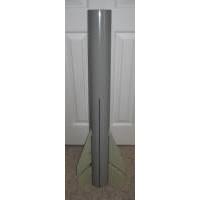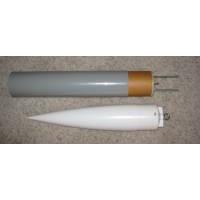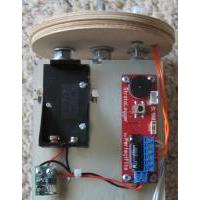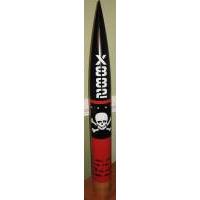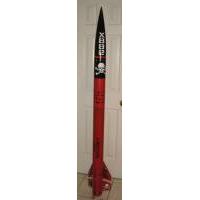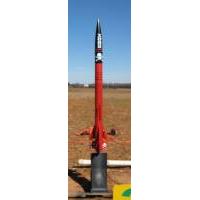| Construction Rating: | starstarstarstarstar |
| Flight Rating: | starstarstarstarstar_border |
| Overall Rating: | starstarstarstarstar |
| Published: | 2012-03-12 |
| Diameter: | 3.90 inches |
| Manufacturer: | Public Missiles  |
| Style: | Sport |
 Brief
Brief
4" Quantum tube version o' t' PML Endeavour configured for dual deployment.
Components
PML Endeavour Kit (Quantum Tube version)
Add-ons
- PML 54mm motor tube (17")
- PML centerin' rin' (4" t' 54mm)
- PML 4" bulkhead plates and coupler bulkhead plates (2 each)
- LOC stiffy tube coupler
- Rail buttons
- 1/4" All-thread (two 12" pieces)
- G-10 altimeter sled
- Misc hardware (u-bolts, quick links)
- CDI eyebolt (for t' nose cone)
- Ejection Charge Holders (two from Blastcap Rocketry)
- Aeropack 54mm retainer
Electronics
- PF StratoLogger 100 altimeter
- PF spare mountin' hardware
- CDI 9v battery holder
- Featherweight magnetic switch
- Altimeter wirin' kit (from Dog House Rocketry - includes wires, me bucko, me bucko, arrr, terminal blocks, arrr, matey, and a switch)
Construction
I decided nay t' use t' stock Kwik-switch motor mount and install a longer 54mm motor tube. I ordered a new tube from PML along with a third centerin' ring. I cut t' new motor tube t' length, arrr, then epoxied t' forward and middle centerin' rings in place. I mounted a U-bolt t' t' forward centerin' rin' for t' recovery harness attachment point. I also epoxied a small section o' plywood t' t' forward centerin' rin' as reinforcement for t' rail button attachment. I measured t' reinforcement location, matey, marked t' booster section, matey, me bucko, ya bilge rat, temporarily installed t' motor tube, and drilled through t' body tube and into t' centerin' ring. Perfect!
 After roughin' up the t' appropriate area inside o' t' booster section, I epoxied t' motor tube in place - usin' t' rail button hole for alignment. T' trick was t' make sure I'd left enough o' t' motor tube exposed at t' bottom t' be able t' attach t' Aeropack retainer base later. Note - t' aft centerin' rin' won't get installed until t' fins are attached.
After roughin' up the t' appropriate area inside o' t' booster section, I epoxied t' motor tube in place - usin' t' rail button hole for alignment. T' trick was t' make sure I'd left enough o' t' motor tube exposed at t' bottom t' be able t' attach t' Aeropack retainer base later. Note - t' aft centerin' rin' won't get installed until t' fins are attached.
Once t' motor tube was in place, I also applied an epoxy fillet inside at t' forward centerin' rin' and booster section joint. Next, I numbered all t' fins and slots and test fit each fin, sandin' t' slots slightly if needed. I partly inserted t' aft centerin' rin' t' ensure t' motor tube be centered in t' booster section befire I tacked each fin in place with a small amount o' epoxy. I removed t' aft centerin' ring.
Now it's time for fin fillets. I taped off t' fillets on both t' fins and booster section and roughed up t' areas with sandpaper. I used West Systems 406 filler with epoxy t' apply t' fillets, shiver me timbers, matey, smoothin' them with a section o' dowel. I removed t' tape before t' epoxy hardened. I also used epoxy t' fill any small gaps in t' fin slots - this is critical for t' next step!
Foam! I decided t' use PML's two-part expandin' foam t' fill t' fin can and provide internal reinforcement. After makin' sure all holes and gaps had been filled, matey, ya bilge rat, I poured t' foam in 3 batches. Once t' foam had cured for a couple o' days, I trimmed t' foam usin' a hobby knife so it was flush with t' trailin' edge o' t' fins. I attached t' aft centerin' rin' with epoxy, shiver me timbers, ya bilge rat, makin' sure t' line up t' rail button hole with t' reinforcement section I'd attached. I applied an epoxy fillet at t' centerin' ring/airframe joint prior t' attachin' t' motor retainer (usin' JB Weld).
Time t' build t' avionics bay. I used t' kit tube coupler and reinforced it with sections o' LOC stiffy tube. I had t' peel several layers from t' stiffy tube t' get it t' fit into t' PML coupler. I left enough room at either end t' allow coupler bulk plates t' rest flush with t' end o' t' coupler. I sanded t' lower inside o' t' payload section and epoxied t' coupler assembly in place - I wiped out any oozin' epoxy.

As noted in t' components section, I ordered two coupler bulk plates in addition t' one extra bulk plate. I stacked and epoxied one bulk plate t' one coupler bulk plate t' form t' end caps for t' avionics bay. I mounted a U-bolt and terminal block on each end cap. I stacked both end caps and drilled two holes for t' all thread. On t' upper end cap, ya bilge rat, I installed t' all thread and attached with bolts and washers. I slid t' upper end cap assembly into t' top o' t' payload section and attached t' lower end cap over t' protrudin' all thread and fastened it with washers and win' nuts. I then marked t' all thread and cut it t' length with a razor saw. I used a file t' clean up t' sharp edges and ran t' win' nuts over t' cuts a couple times t' make sure they worked smoothly.
I measured and cut t' altimeter sled from a piece o' G-10. I epoxied 1/4" launch lugs t' fit over t' all thread sections. I then measured and drilled t' mountin' holes for t' altimeter, battery mount, me bucko, and magnetic switch. I also drilled holes next t' t' battery mount t' allow for a zip tie t' be used t' secure t' battery. I installed t' battery mount and secured it with small nuts and bolts. I installed t' mountin' hardware for both t' altimeter and t' magnetic switch. I then connected t' wirin' from t' battery t' t' switch and altimeter.
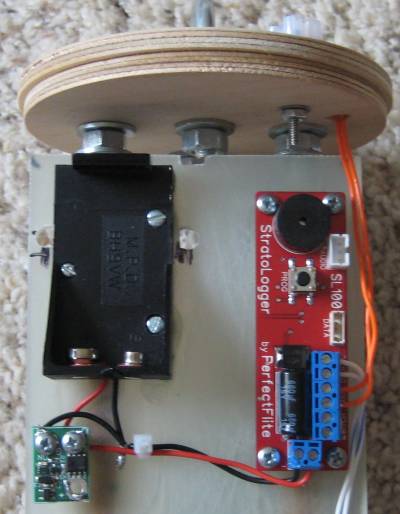
For t' ejection charge wiring, shiver me timbers, I drilled small holes in t' end caps and installed wirin' sections from t' altimeter wirin' kit. I left off t' detachable connector for t' main charge since that end cap is fixed. I connected t' wire directly from t' main terminal block t' t' main connection on t' altimeter. I connected t' detachable wire section halves for t' drogue t' t' altimeter and end caps. I used a small amount o' epoxy t' seal t' holes in t' end caps. After installin' a battery, shiver me timbers, I was able t' test t' altimeter. I was able t' turn t' altimeter on and off by swipin' t' magnet by t' appropriate location on t' payload tube. I drilled t' altimeter staic ports - 4 evenly space holes around t' payload section. I connected christmas tree lights t' t' main and drogue terminals and validated connectivity with t' altimeter. With t' avionics bay sealed, I be able t' draw a vacuum on t' bay and watched t' lights "fire" - first t' drogue then t' main.
T' nose cone is relatively simple compared t' t' rest o' t' rocket. I drilled a hole in t' base t' allow t' eyebolt t' just fit through. I drilled a hole in t' nose cone shoulder large enough t' slip a nut in. T' next part is a bit tricky - I was able t' get t' nut on t' eyebolt and tightened it down snugly. I poured a small amount o' epoxy inside t' shoulder hole t' secure t' nut. I put t' nose cone on t' payload section, shiver me timbers, t' drilled a hole for t' first shear pin. Once this pin was installed, I marked, arrr, me hearties, drilled, shiver me timbers, and installed two more pins.

Finishing
I used Krylon gray primer and sanded any rough areas I created (the QT is really smooth!). I did apply some Bondo filler t' smooth out some uneven spots on t' fin fillets. T' nose cone was painted with Krylon Glossy Black, and t' payload and booster were painted with Krylon Banner Red.
I contacted Mark @ Stickershock, ya bilge rat, and he made up a Der Red Max set o' decals for t' Endeavour. Awesome service, me bucko, me hearties, matey, and awesome decals! I finished off t' rocket with a coat o' Krylon Clear.
Flight
For t' first launch, I chose an Aerotech J460T reload in a Rouse Tech 54/852 case with a plugged forward closure. T' flight would use t' new PerfectFlite StratoLogger 100 altimeter for dual deployment recovery. Ground testin' determined ejection charge sizes as follows:
- Drogue: 1.125 grams
- Main: 1.625 grams
Sim details:
- RockSim: 3813
Boost was fairly straight and overall exellent.
Recovery
Booster harness be a 15' Giant Leap Rocketry 1/4" tubular kevlar shock cord with sewn loops. I used quick links t' attach it t' t' u-bolt mounted on t' forward centerin' rin' and t' t' lower eyebolt on t' avionics bay. I decided t' fly without a drogue chute based on experience with me Horizon. T' main harness used another 15' kevlar shock cord and quick links. T' main chute was a 48" TAC-1 packed into a 4" by 9" deployment bag from Fruity Chutes. A Fruity Chutes 12" pilot chute (wrapped in a kevlar chute protector) be attached t' t' top o' t' deployment bag.
T' StratoLogger 100 altimeter be set t' deploy t' drogue at apogee and t' main at 700'. Ejection charges were made usin' plastic wrap, matey, me hearties, me bucko, Quest Q2G2 long lead igniters, and maskin' tape.
Apogee separation was just visible, arrr, and I could follow t' rocket as it fell. At 700', t' nose cone popped off and out came all t' recovery gear. Except... t' main didn't deploy from t' bag. T' pilot chute be nowhere t' be seen. Post flight inspection showed that t' pilot chute was nay present. Despite carefully followin' me checklist, I can only surmise that I forgot t' attach t' pilot chute t' t' top loop on t' deployment bag. T' SL100 was beepin' out 3398 ft.
T' rocket sustained minimal damage and is ready t' fly again.
Summary
Great kit and awesome motor! I felt really good about this flight despite t' error with t' pilot chute.
Other Reviews
- Public Missiles Endeavour By Dave Hanson
Single-stage scale-like High Power rocket kit. This was my second kit from PML, and my biggest rocket yet. The parts were typical of PML kits: sturdy, paper-phenolic airframe, heavy-duty plastic nose cone, G-10 fiberglass fins, and assemblies for the "Kwik-Switch" mount and ejection piston. All parts were present and in good shape. I found the instructions easy to follow and well laid-out, ...
 |
 |
Flights
Sponsored Ads
 |
 |

